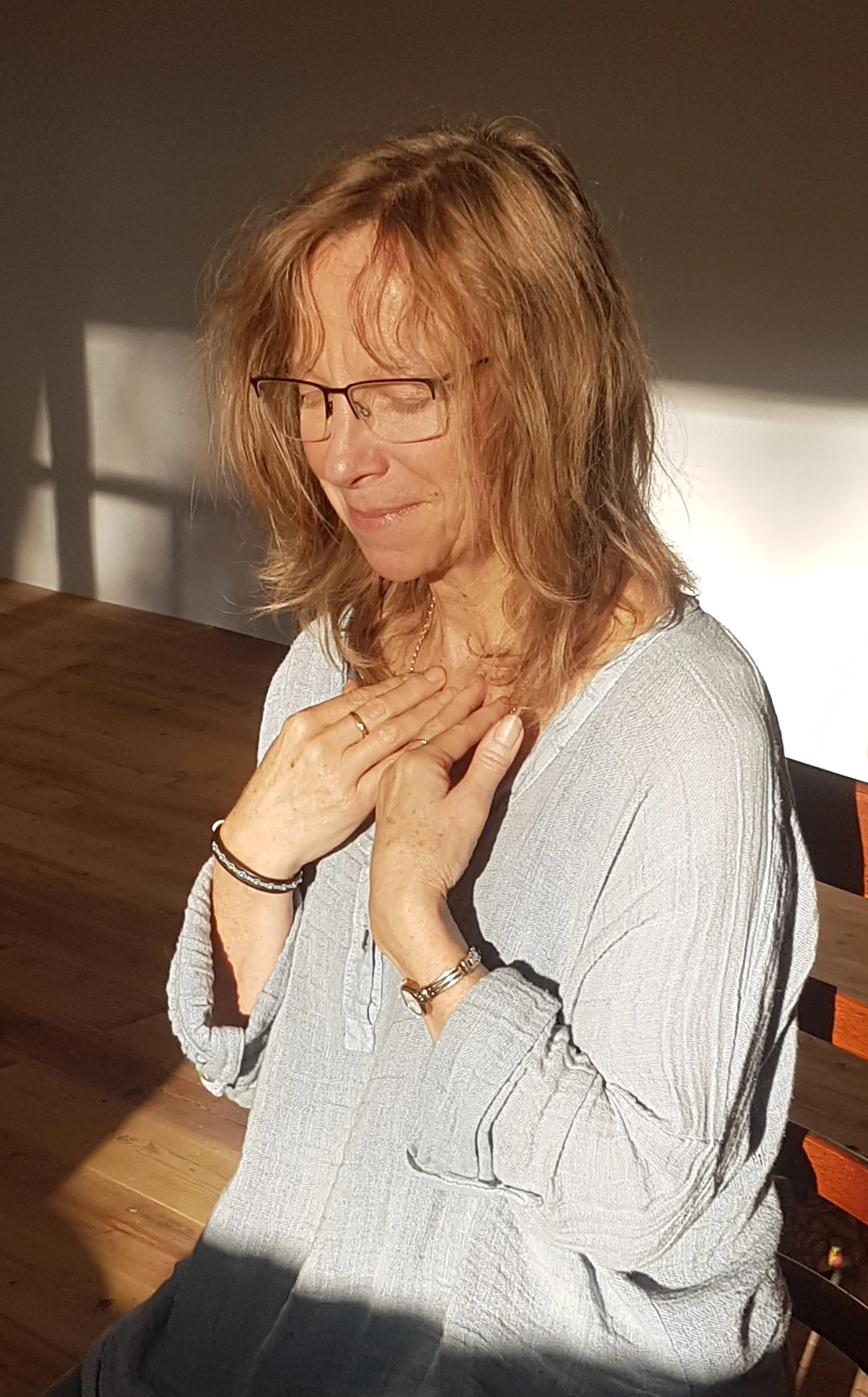INTRODUCTION
What is Sophrology?
Many people ask if Sophrology is like mindfulness…
There are similarities between the two in that Sophrology begins with shifting focus from the mind stream to the body.
Sophrology goes further and engages a scientifically structured positivity practice that slowly and subtly changes the consciousness to a more harmonious way of being.
Whilst the mind can project itself from the present into the past or the future, at times resulting in low mood, stress or anxiety, the body is always in the present moment.
To enact change in the mind, a deep and authentic connection to the body is therefore the first priority of the practice.
By connecting to the breath and the 5 senses, Sophrology enables us to visualise with a vividness that convinces the mind that the experience, whether invented or re-lived, is really happening. In this way, we are able to build positivity into the neural pathways.
In time, we develop an awareness of what we are focussing on in our thoughts and the emotions we are experiencing as a result. We can then make a conscious choice about whether we wish to continue in the same vein or make changes. The daily exercises give us the tools to do this.
Sophrology is a journey of self-awareness which gives us the power to choose what we think about and therefore what emotions are most prolific in our lives.
Note: The practice of Sophrology is not a substitute for conventional medicine but a complement.
“Jenni put me back in control of my mind and thoughts”
- Lily B
The Practice
Course Format
Many people work one to one with a Sophrologist to address a particular issue for the needed number of sessions, but in its course format, Sophrology has 3 ‘Cycles’:
The First Cycle is most popular and covers Parts 1-4 sequentially.
(The other 2 two cycles cover Parts 5-12 and are referred to as the ‘Advanced Sophrology’ courses.)
PART ONE
Engaging the Present
-
Inspired by Raja yoga, Part 1 teaches simple relaxation exercises incorporating visualisation, breath and movement to help notice body sensations and increase present time awareness. You are encouraged to live in the moment without judgement and to experience the world ‘as if for the first time’.
PART TWO
Focus on the Future
-
Part 2 is inspired by the teachings of Buddhism. You will learn how to explore your 5 senses and notice how your mind interprets these through the ‘lenses’ of your prior experiences. The exercises are designed to help create a positive outlook, focussing on goals and projects in the future. There are strategies to reduce mind chatter, unpleasant thoughts and fear of the future.
PART THREE
Working with the Past
-
Part 3 draws on the philosophy of Zen. You will learn how to ‘water’ good memories and how to diminish the impact of those you’d prefer you didn’t have. The exercises now begin to incorporate walking meditations where you learn to take your experience of being present and maintain it as you move through space and time.
PART FOUR
All Becomes One
-
In the final part of the Sophrology journey, we draw together the experiences of the prior ones with an exploration of values. We do this by noticing the values we prioritise in our lives and how they affect every decision we make.
We continue our walking meditations in which we experience the oneness of life and our connectedness to all there is.
By this stage, there is a strengthening in the sense of who you are - a confidence that you are making right decisions, that you are good enough and that you can trust your intuition.
These four parts make up the Foundation Cycle in Sophro-ki Sophrology which, for most people, feels complete.
If however, you wish to delve into deeper levels of self-discovery, you can continue with the 2nd and 3rd Cycles, the two of which combined take a further 32 weeks of classes to complete.
Sample Practice
Sophrology exercises always start with a 'body scan' to help connect your mind and body. If you're curious, press play, close your eyes and try it now.
Frequently Asked Questions
-
Parts 1-4 take an 8-week term each with a break for school holidays in between. Some people like to take a longer break or longer than 8 weeks and that’s fine too. The course is cumulative though, so the Parts are always taught sequentially.
There is no obligation to complete more than one Part but, whilst benefits will take place at every stage, experiencing the whole Cycle is like a ‘complete renovation’ for the mind whilst doing Part 1 on it’s own is like ‘doing up one room’ in comparison!
-
Small classes run weekly for 60-90 minutes, depending on how many are in the group.
-
Experiences from the prior week’s exercise are shared, any theory discussed, then the exercise runs for 15-20 minutes.
A short debrief ends the session and a recording of the exercise is emailed to participants so that they might repeat it throughout the week until the following session.
-
Everyone’s journey is highly individual so it depends where in the course you come across things you particularly want to change. For example, if sleep was an issue for you, you may find improvement in Week 4 when we do the exercise for improving sleep. Many people report noticing particularly marked changes in the way they feel by the end of Part 2.
-
A typical exercise goes for 15-20 minutes.
-
Yes, individual sessions to work on a specific issue can be arranged via the Contact page.
Sometimes Parts from the full course also end up running with just one participant, but a group dynamic is a valuable context as it adds sociability to the experience and helps illustrate that there’s no right or wrong way to respond to the exercises – Sophrology is a guided, but very much individual journey of self-discovery and development.
The Origins
The word ‘Sophrology’ is derived from the Greek:
‘Sos’ which means harmony, ‘phren’ meaning consciousness and ‘logos’ meaning ‘study of’.
The literal translation is: The Study of Harmonising the Consciousness.
The practice is a blend of Western and Eastern mental health techniques, created in Spain by neuropsychiatrist, Professor Alfonso Caycedo in 1960.
Seeking alternatives to drugs and shock therapy, he travelled widely in the East with his wife who was a yoga teacher. They studied Yoga, Zen, meditation and Buddhism, searching for core practices to combine with psychiatry that would speedily and effectively produce positive results.
For many years, the work was taught soley in French and Spanish but it is now becoming more broadly known in the English-speaking world.
Sophro Connections uses Sophro-ki® Sophrology which was developed by Dorna Revie, Swiss Master Sophrologist. Dorna studied for years with Professor Caycedo and later, his daughter, Natalia.
This Sophrology incorporates Neuro-Linguistic Programming, Cognitive Psychology, breath work and gentle movement.
Global Context
Sophrology is well-respected and widely used for stress management and self-development throughout Continental Europe…
It is applied in education, corporate and social environments throughout France, Switzerland, Belgium and Spain and 90% of the top sports people in Switzerland work with a Sophrologist. Many Swiss hospitals use Sophrology to prepare patients for surgical interventions, EMR scans and childbirth. It is also one of the top methods for pre and post-natal care in Japan, Korea and France.
There are many Sophrology schools, federations and associations throughout French-speaking countries where the method has been practised for decades.
It is now recognized in the UK and United States and the International Sophrology Federation promotes awareness of the practice and provides evidence of its effectiveness in increasing health, wellbeing and performance. It also maintains the integrity of the method as it expands around the world and encourages the ongoing professional development of its members.
In Switzerland, Sophrology is reimbursed by the Swiss National Insurance as it has been proven that people who practise Sophrology regularly, reduce their medication intake by 30%.
“I have completely surprised myself at how calmly I have accepted this life-changing circumstance. Thanks to Sophrology, my improved self-confidence keeps me positive”.
- Susie P.






